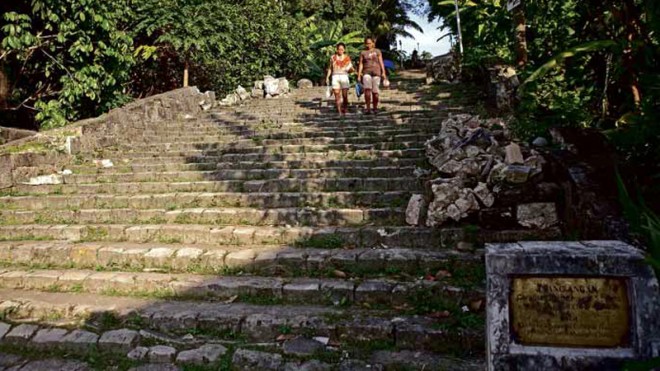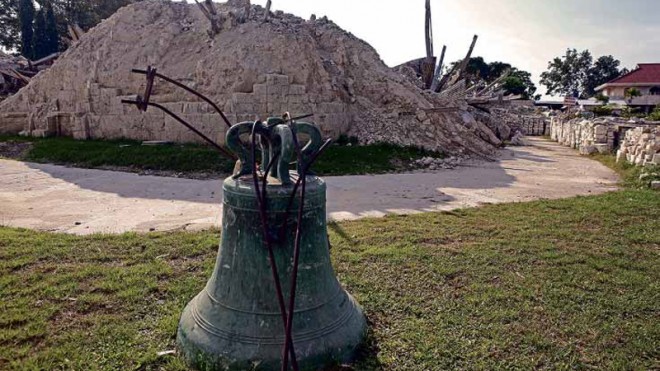Bells to ring in Bohol churches at 8:12 a.m. Wednesday
(Last of three parts)
MARIBOJOC, Bohol—For the first time in a year, the church bells of Holy Cross Parish will ring at exactly 8:12 a.m. today, Wednesday, for 33 seconds.
But the parish priest, Fr. Warren Abarquez, will ring only one bell, one that has been mounted on a makeshift belfry put up for the one-year anniversary commemorating the earthquake that killed more than 200 people.
The killer quake also affected 43 out of 47 towns and one city in the province.
To commemorate the day, other church bells will ring and police patrol cars, ambulances and other vehicles will blow their horns at 8:12 a.m. for 33 seconds—the exact time and duration of the tremor that shook Bohol province last year.
Article continues after this advertisement“The sound of the bells has been a symbol to call or gather people. It will also remind the people that in spite of what happened, we were united in helping each other to rise again,” Abarquez said.
Article continues after this advertisementProvincial Administrator Alfonso Damalerio said the ringing of the bells would remind the people of how the quake flattened three churches and damaged 22 others in Bohol.
Reminder to all
“The ringing of bells and the sound of the alarms will call the attention of the public,” Abarquez told the Inquirer.
“The sound of the alarms and sirens will also be a reminder to us of all the individuals and groups who helped us during the rescue, relief and retrieval operations.”
At least 211 people were killed while eight remained missing in the wake of the strongest quake to hit the island-province in recent years.
One of the three churches destroyed was Holy Cross Parish, where only the statue of Christ the King now stands. The two others were Our Lady of Light Church in Loon town and St. Michael Parish Church in Clarin town.
Seven bells
For the commemoration, the Marijoboc church will use the smallest of seven centuries-old bells. It weighs about 10 kilos and is mounted on a makeshift belfry 3 meters (10 feet) tall.
Five big bells, each weighing about 350 kilos, have been placed beside the alternative church, which looks like a covered court—no walls or steel columns and no GI (galvanized iron) sheets for roof.
The seventh bell is kept by Abarquez in his residence out of fear it might be stolen because it weighs only about 70 kilos.
Abarquez has assigned a volunteer to ring the bell while the parishioners gather at the Municipal Cultural Center for a program.
Special holiday
Malacañang has declared Oct. 15 a special nonworking holiday in the province.
After the ringing of the bells, Bishop Leonardo Medroso of the Diocese of Tagbilaran will hold a Mass at St. Joseph Cathedral for the quake victims.
Bohol Gov. Edgar Chatto will lead the unveiling of a memorial shrine at Banat-i Hill in Barangay (village) Bool, Tagbilaran City, at 10 a.m.
At 1 p.m., an art gallery showcasing photo and video exhibits, as well as paintings of the quake aftermath, will open in Sta. Monica Parish convent in Alburquerque town.
A commemoration program will be held at 4 p.m. at CPG Sports Complex in Tagbilaran.
Slowly but surely
Slowly but surely, Bohol is bouncing back from quake.
Maribojoc Mayor Leoncio Evasco Jr. has learned an important lesson during the devastating earthquake that hit Bohol last year: Do not rely on the national government for help.
“We will rise even without them,” he told the Inquirer.
He said the only aid his town had received from a national agency was the Emergency Housing Assistance Program given by the National Housing Authority (NHA) for the quake victims.
Each of the 3,347 families whose houses were destroyed has received P10,000 worth of housing materials from the NHA.
Evasco said that up to now, families were still waiting for the P5.2-million Emergency Shelter Assistance (ESA) from the Department of Social Welfare and Development (DSWD), which he was told was being processed.
Good thing nongovernment organizations, private groups and concerned individuals have stepped in and helped, especially in areas where government support was lacking.
They even helped clear the debris and gave shelter to those displaced.
Private help
Several Boholanos also didn’t wait for the government to help, and either repaired or rebuilt their houses themselves.
As of Sept. 30, data from the Provincial Disaster Risk Reduction and Management Council (PDRRMC) showed that of the 95,884 families whose houses were destroyed or damaged, 29,760 were able to repair their houses using the ESA.
A total of 2,716 others rebuilt their houses on their own.
At least 38,801 families were able to repair their houses using the materials given by the NHA, the data showed.
At least 14,899 families were able to repair their houses with the help of private groups. Help for 2,438 others is still undergoing a revalidation process to see if they could receive permanent shelter.
Permanent shelters
A total of 1,575 families are now living in permanent shelters provided by the private sector.
The construction of 5,367 permanent shelters funded by the DSWD and Habitat for Humanity of the Philippines is ongoing.
Hardest hit
PDRRMC data also showed that 4,358 families are living in temporary or transitional houses provided by the private groups.
Each transitional house has a floor area of 10 square meters. Its floors are made of bamboo while the walls are of amakan, or bamboo matting, and the roof is made of nipa.
At least 200 families from Loon—the hardest-hit municipality—still live in bunkhouses provided by the Philippine Ports Authority.
Some government agencies have used their existing funds for repairs while waiting for financial assistance from the national government to arrive.
Two steel bridges were put up to temporarily replace those that collapsed.
Signs of recovery
The Department of Health used its funds to retrofit a portion of the Congressman Natalio Castillo Memorial Hospital in Loon so it can serve the municipality and other towns.
The Department of Education (DepEd) has used its quick response fund and savings to repair and rebuild a number of classrooms.
With the help of the private sector and other donors, the DepEd only has to build 132 classrooms out of 1,260 destroyed. At least 705 classrooms have yet to be repaired.
Chatto said the province had not fully recovered but traces of recovery could already be seen.
Chatto said it would take time before his province’s request for P12 billion in rehabilitation funds could be released.
But he said he had been regularly writing to Cabinet members to ask for updates.
In the meantime, the province is looking for relocation sites for families still in temporary shelters.
Relocation site
The provincial government, in partnership with the DSWD and Habitat for Humanity Philippines, is targeting to build 8,083 permanent shelters.
The relocation site has to be certified by the Mines and Geosciences Bureau as safe for occupancy after several sinkholes emerged following the quake.
Finding a relocation site may not be all that easy, officials said.
The provincial government is also working to return the tourism industry to its pre-earthquake level by adding more tourist attractions.
The provincial government has included in its tour packages pictures of the ruins of the old churches as well as those of unique geological sites that emerged after the earthquake.

DAMAGED HERITAGE The stairs of a national heritage site in Loon, Bohol province, have yet to be repaired one year after it was damaged by 7.2-magnitude earthquake. PHOTOS BY LITOTECSON/CEBU DAILY NEWS
Tour operators resumed educational tours for students in the last week of August.
Tourist arrivals
The provincial government is also exploring the possibility of developing an ecotour package for each town in order to boost tourist arrivals.
One is Anda town, a fifth-class municipality 99 kilometers from Tagbilaran. It has a 2-km white sand beach and crystal clear water and an island where tourists can go spelunking, swimming, explore the mangrove forests, or just commune with nature.
According to provincial tourism officer Josephine Cabarrus, tourism arrivals in Bohol have slowly risen from a low of 60,602 in the last quarter of 2013 to 92,040 arrivals in the second quarter this year.
But it is still below the pre-earthquake level of 240,505 from January to June 2013 alone.
Rescue unit
Despite the devastation, the earthquake has allowed local officials to see the gaps in responding to calamities, according to Alfonso Damalerio, provincial administrator.
Aside from regular earthquake drills held down to the purok levels, the province has put up an incident command system integration to ensure a smooth and comprehensive reporting of damage assessment from each local government unit.
Different agencies have strengthened their disaster preparedness plans. The province has also identified relief and evacuation centers in case another quake strikes.
Their rescue unit, Tarsier 117 (Telephone and Radio System Integrated Emergency Response), underwent training with American troops during the RP-US Balikatan Exercises on urban search and rescue held in Cebu last May.
Resilient and united
Damalerio said Boholanos were resilient and united, which would make recovery much easier.
He said that after the quake, their battle cry had become “Padayon Bol-anon ug padayon Bohol (Move forward Boholanos and move forward Bohol).”
Slowly but surely, Bohol has.
FIRST PART
SECOND PART
